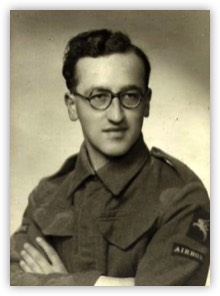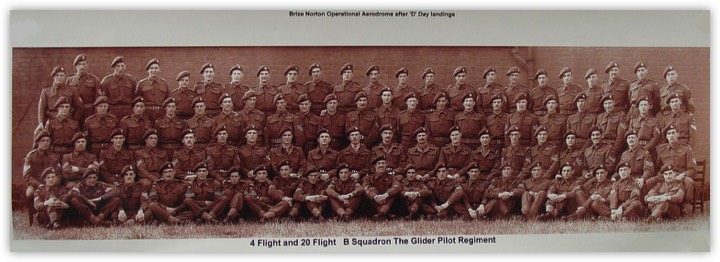
The Glider Pilot Regiment
The Glider Pilot Regiment was possibly the shortest lived and least known unit of the Second World War. It was part of the Airborne Force of 5,000 ordered to be formed by Prime Minister Winston Churchill in 1941.
The Regiment was formally inaugurated on 24th February 1942 as part of the Army Air Corps which then comprised the Glider Pilot Regiment, the Parachute Regiment and the Special Air Service.
Volunteers were called for from Army units and after military and RAF aircrew selection tests they were subjected to a rigorous regime of military training designed to make them "Total Soldiers". This was to train them to use all weapons and equipment of the fighting soldiers they carried into battle so that they could fight alongside them on the ground.
The man behind this concept was Colonel George Chatterton, a charismatic leader and a ruthless disciplinarian. His experience as a pre war RAF fighter pilot and subsequently an infantry officer fitted him well to the task of turning highly trained determined soldiers into skilful pilots. The motto of the Regiment was "Nothing is Impossible".
Their Horsa gliders, the first of which was designed and built in a few months, were a tribute to British industry. Capable of carrying 28 fully armed and equipped airborne soldiers, or a Jeep and trailer or gun, they enormously enhanced the mobility and punch of the otherwise lightly armed airborne troops. A larger glider, the Hamilcar, could carry a seven ton tank! A smaller American glider, the Waco CG4A, officially called the Hadrian by the British, but "Waco" by the pilots and soldiers, was used in Sicily and in Burma. The Waco's steel frame was better suited to jungle operations than the wooden Horsa.
The advantage of the glider was that it could deliver an airborne platoon with all its equipment to a precise spot, day or night, to achieve surprise. The most spectacular example of this was the capture of the Orne bridges in Normandy on D Day. A similar number of men dropped by parachute would be spread over a large area. Gliders also carried the heavier equipment of the Parachute Regiment, Royal Artillery and Royal Engineers.
Massed airborne landings at Sicily, Normandy and Arnhem achieved success but at great cost. The Airborne Forces at Arnhem did not lose the battle, they were ordered to hold for two or possibly three days, they held out for eight days. The Regiments casualties were the highest at Arnhem, 90% were killed, wounded or taken prisoner of war.
These losses were made up by the secondment to the Regiment of Royal Air Force pilots and several hundreds of them took part in the greatest and most successful airborne operation of the war, Operation Varsity, the Crossing of the Rhine. The RAF pilots acquitted themselves with great gallantry, in the air and on the ground, 60% of the Regiment's killed in action on that day were RAF pilots seconded to the Glider Pilot Regiment.
The very heavy casualties sustained by the gliders in the war sadly brought an end to the assault glider. Their operational role is now carried out by the support helicopters of the Royal Air Force.
After the war, former Army glider pilots took part as light aircraft pilots in the Korean War and other emergencies. Eventually these pilots joined with the Royal Artillery Air Observation Post squadrons to form today's Army Air Corps. The Army Air Corps takes great pride in the traditions it inherited from the Glider Pilot Regiment and is a worthy successor to that short lived Regiment of flying "total soldiers". The Army Air Corps strongly supports the Glider Pilot Regimental Association and represents the Regiment at all commemorative occasions.
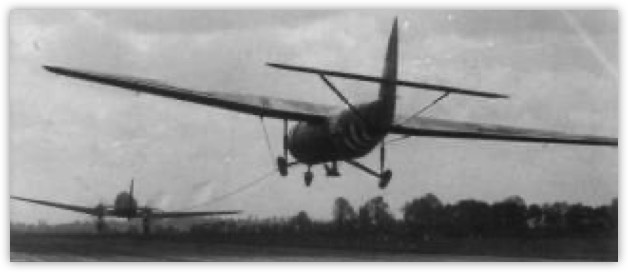
The South Staffords and Assault Gliders in World War Two
A Brief Summary
Two battalions of the South Staffordshire Regiment (now part of the Staffordshire Regiment) flew to battle in gliders in WW2. The 1st Battalion fought in the Second Chindit Campaign behind Japanese lines in Burma, they were air lifted in mainly by American WACO CG4A gliders. The 2nd Battalion joined the 1st Airborne Division in 1942, and flew to battle in gliders (mainly WACO CG4A) in the Sicily landings in 1943, and to the Battle of Arnhem in 1944 (in Horsa's). In these actions, the 1st Battalion won one VC and the 2nd Battalion won two VCs.
Sicily Landings
The 2nd South Staffords were sent to North Africa in May 1943 as part of the 1st Airborne Division, to take part in the first Allied invasion of Europe, the Sicily Landings. These took place on 10th July 1943 and were preceded by dropping parachute and glider borne troops to seize and secure vital ground and bridges in advance of the seaborne landings.
This was the first major airborne assault attempted by the Allies and, perhaps inevitably, everything did not run smoothly. The weather was overcast with unexpected high winds. In their night approach to Sicily thunder and anti aircraft fire from the shore and from the landing ships confused many and led to gliders being cast off whilst still too far out to sea. Forty seven out of one hundred and thirty four gliders failed to reach land. Many were picked up by naval vessels and eventually joined the battle, but many South Staffords were drowned.
Those who made it to the land found themselves widely dispersed, many key personnel having been lost at sea. The battle was fought by-sub units and detachments. Most objectives were taken by these small groups, notably the Ponte Grande Bridge, a key point carrying the main road to Syracuse. Only two gliders from C Company (assigned to capture the Ponte Grande Bridge) actually landed near their objective and one of these (with the Company Commander on board) blew up on landing. So it fell to Lt Withers (who won an MC in this action) and 15 Platoon to take and hold the bridge for some fifteen hours with other South Staffords, part of the Brigade defence platoon, glider pilots and Royal Engineers. By 1600 hours, they were out of ammunition and over-run by the enemy but almost immediately were relieved by the seaborne Royal Scots Fusiliers before the bridge could be demolished by the enemy. The nearby railway bridge was captured by A Company and the way to Syracuse was open. This action was integral to the successful and rapid advance through Sicily.
Second Chindit Campaign
1st South Staffords were selected to join the second Chindit operation which took place between March and July 1944. This involved six groups of brigade equivalence, in effect, a division's worth of troops. 1st South Staffords operated under Brigadier Calvert in 77 Bde, landing at Broadway, establishing the famous block at White City and supporting 111 Bde in another block at Blackpool. These codewords were for features or areas which once captured and held, prevented the movement of Japanese troops and supplies to oppose the main Allied advance through Burma. Finally, combined with Chinese troops, they captured Mogaung, one of the two Allied objectives laid down at the Quebec Conference and materially assisted in the capture of the other (Myitkyina).
These victories were gained at terrible cost. 1st South Staffords air-landed with roughly 830 men and were reinforced during the campaign (March to August 1944) with about eighty more men. They lost 150 killed and more than 250 wounded, disease led to a further 180 men being evacuated. The gallantry of those who took part cannot be over estimated. Lt Cairns won a VC. He died of wounds, having continued to lead his men in a successful assault to secure White City after an arm had been completely severed, driving back the Japanese and advancing until he collapsed from loss of blood. The battalion also gained a DSO, seven MCs, three DCMs and seven MMs.
Arnhem
2nd South Staffords, which was part of 1st Airlanding Brigade under Brig Hicks, was split into two elements with B and D Companies arriving in the first lift. After securing the landing area they were ordered to move forward to the Arnhem Bridge held by 2 Para and set off with their CO, Lt Col McCardie. They fought their way through several ambushes before being held up by strong forces in the area of St Elizabeth's Hospital. The remainder of the battalion, arriving in the second lift, was sent on behind, having to fight through at least one of the ambushes that had held up the leading elements on the previous day. However, in spite of attempts to coordinate an advance with 11 Para, 2nd South Staffords were unable to reach the bridge and lost very heavily in the inevitable street fighting en route.
Such men as remained were withdrawn to the Oosterbeek perimeter, where two VCs were won by the South Staffords. The first was for an isolated action by L/Sgt John Baskeyfield single-handedly engaging three enemy armoured vehicles with the two six pounder anti tank guns under his command, after all his men had been killed or wounded. He stopped two tanks and damaged a third but at the cost of his own life. The second VC was awarded for sustained courage over several days during which Major Robert Cain repeatedly engaged enemy tanks with PIAT's (elementary anti tank weapon with a range of 50 yards) and once with a light mortar, all the while encouraging the men under his command.
Although the battle was a failure, the heroism of the 2nd South Staffords, (the only battalion to win two VCs in a single battle in World War Two) and of course all of those who fought at Arnhem, remains an inspiration to this day.
Conclusions
As this brief description has shown, gliders were integral to the invasion of Europe and to flanking and diversionary movements in the Far East jungle. Those who flew in them performed great deeds of valour once battle was joined and their part in history is assured. The Staffordshire Regiment is enormously proud of its predecessor battalions, the 1st and 2nd South Staffords, and of their gallant and important role in this short-lived but significant phase in the art of war.
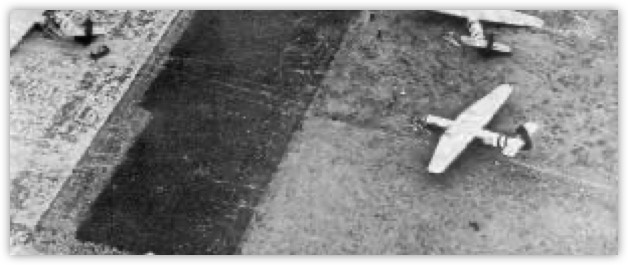
Oxfordshire and Buckinghamshire Light Infantry
A Brief Summary
The 2nd Battalion, Oxfordshire and Buckinghamshire Light Infantry (the 52nd) became an airborne battalion in 1941. Initially in 1st Airborne Division and then in 6th Airborne Division. The battalion provided the very first troops to land in Normandy in the D Day invasion of 1944. Their task was to secure vital bridges, some six miles inland, and to hold them until relieved by the sea borne invasion force.
Normandy
Shortly after midnight on the morning of 6th June 1944, a force of six Horsa gliders carrying 139 men of 2 Oxf & Bucks, together with 30 Royal Engineers, all under the command of Major R.J.Howard, landed in darkness to capture the bridges over the Caen Canal (Pegasus Bridge) and the River Orne (Horsa Bridge) by surprise coup de main raid.The attack on Pegasus Bridge was entirely successful and the bridge was held against fierce counter attacks until the Oxf & Bucks, joined by 7 Para, were relieved by sea borne troops.
Of the three gliders assigned to Horsa Bridge, two landed at the correct place and the Oxf & Bucks captured and held that bridge. The third glider was released at the wrong place and landed at the wrong bridge, a bridge over the River Dives about seven miles away. Nevertheless the Oxf & Bucks captured that bridge and then made their way to Ranville, through German lines, where they rejoined their batallion. Major John Howard was awarded the DSO for his skill and leadership in this action.
By the end of D+2, 6th Airborne Division was fully established on the East bank of the River Orne and held this vital sector for several months against repeated enemy attacks. The Oxf & Bucks played a major role in the major defensive battles at Escoville and Herouvillette from 7th to 14th June 1944, and then on the Breville Ridge for two months. After advancing to the River Seine in August, the battalion was withdrawn to England on 1st September 1944 to re-form.
Ardennes (The Battle of the Bulge)
The 2nd Oxf & Bucks were rushed back to Belgium to help counter the massive German breakthrough, which was intended to drive a wedge through to Antwerp, between the British and American armies. After extremely hard fighting in very cold weather, the German advance was turned into disaster when the British and American troops closed the neck of the bulge.
The Rhine Crossing
On 24th March 1945, 2 Oxf & Bucks took part in their second airborne operation, the Crossing of the Rhine. Although suffering over 400 casualties in the air and on landing. The battalion captured all of its objectives.
The bridge at Hamminkeln was taken by a platoon of the Oxf & Bucks by bayonet charge lead by Lieut Hugh Clark who was awarded an MC for this action. Determined counter attacks by German infantry and tanks were held off by 6 pdr anti tank guns of the Oxf & Bucks lead by Lieut David Rice, but with limited success. The 6 pdr shot simply bounced off the German Tiger tanks, but they were held off long enough for Royal Air Force Typhoon aircraft to be called up to finish them off.
The battalion then took a leading part in the 300 mile advance across Germany to meet the Russians near Wismar on the Baltic in May 1945. Most of the advance was on foot and it included an opposed assault crossing of the River Weser. The battalion was selected to provide the guard of honour for the meeting of Field Marshal Montgomery, with his Russian counterpart, Marshal Rokossovsky on 7th May 1945 at Wismar.
Conclusion
Few regiments of the British Army fought longer and harder than the 2 Oxf & Bucks in the great campaign from Normandy to the Baltic. "A Regiment never surpassed in arms since arms were first borne by man". (Sir William Napier 1820).
After several re-organisations of the British Army, the Oxfordshire and Buckinghamshire Light Infantry is incorporated in the Royal Green Jackets, which Regiment proudly continues the traditions and the spirit of its predecessor Regiments.
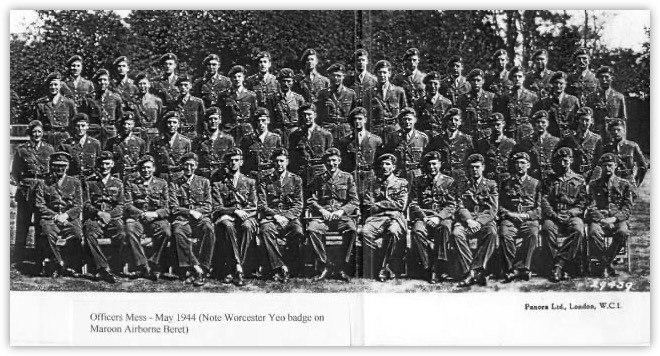
The Queen’s Own Worcestershire Hussars
To explain the history of The Queen's Own Worcestershire Hussars, and particularly with regard as to how the Regiment found itself as the first gunners to be flown into action against an enemy in the Second World War, we must first look at the threat of an earlier invasion to these shores in 1793-4.
At this time the Emperor Napoleon Bonaparte was rampaging his way across Europe and threatened Great Britain with his victorious army. To counter this invasion threat the government tasked local authorities with the raising of troops of Yeomanry Cavalry and so came into being The Worcestershire Yeomanry Cavalry who some 40 years later became The Queen's Own Worcestershire Hussars in recognition of the Regiment escorting Her Majesty Queen Victoria on a visit to the County in 1837. During the war in South Africa the Regiment provided volunteers who made up the 16th Coy. 5th Batt. Imperial Yeomanry.
At the outbreak of hostilities leading to The Great War (1914-1918) the Regiment was sent to Egypt as part of the 2nd Mounted Division. They served with distinction in Gallipoli and Palestine and took part in what is considered to be one of the last great classic cavalry charges and certainly the last ever charge to capture field guns.
In 1920 the Worcestershire Yeomanry were converted to artillery and provided two batteries in 100th (Worcestershire and Oxfordshire Yeomanry) Brigade, Royal Field Artillery. The Regiment was re-roled as an anti-tank regiment in 1938 as war clouds were again gathering across Europe.
The Regiment were mobilised days before the outbreak of War and were sent as part of The British Expeditionary Force to France just prior to Christmas 1939. They served in the advance through France into the Low Countries and were then ordered to cover the withdrawal of the BEF to the Dunkirk beaches. Although many Officers and Soldiers were killed, wounded or captured many, against all odds, were evacuated from the beaches and returned to the UK to be reformed.
They were reformed as Anti Tank Gunners and trained in this role until October 1943. They were then asked to become the Field Artillery in support of the 6th Airborne Brigade and were to be equipped with the new, lightweight and highly accurate American manufactured 75mm Pak Howitzer towed into action by a jeep containing the crew and delivered to the point of action by Glider. The Regiment took part in the Normandy landings, observers and signallers by parachute, one battery by glider and the remainder in the sea-borne invasion. The Regiment took a very active part until August and until they reached the River Seine. They were then withdrawn to enable them to work up towards the invasion of Germany. However, by the winter of 1944 they were back assisting in repulsing the German counter attack which came to be known as The Battle of the Bulge. Thereafter, they took part in the 'Bouncing' or Crossing of the Rhine and the move into Germany.

Above: A gun detachment of 53rd (Worcestershire Yeomanry) Airlanding Light Regiment Royal Artillery with its US M8 75mm pack howitzer
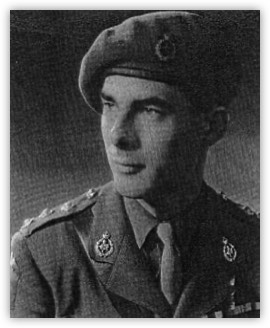
Above right: A photograph of Captain O. E. Brownlow-Wray MC of 53rd (WY) Airlanding Light Regiment RA. showing the pear blossom cap badge and 'collar dogs' of the Worcestershire Yeomanry which were worn by the officers of the regiment. Warrant officers, NCOs and gunners wore the Royal Artillery's insignia. (Photos: Imperial War Museum & Maj O. R. Brownlow-Wray MC)
The Regiment is credited, through lineage, as having formed the Regular Airborne Gunner Regiment of 7th (Para) Royal Horse Artillery. In 1946 the Regiment (QOWH) was demobilised and placed in suspended animation. This did not last for long and in 1947 the Regiment was reformed as 300th (Worcestershire Yeomanry) Anti Tank Regiment RA. However, in 1950 it was transferred to the Royal Armoured Corps as The Queen's Own Worcestershire Hussars and equipped with tanks. It served as such until amalgamation with The Warwickshire Yeomanry in 1956 when the new Regiment was granted the title of The Queen's Own Warwickshire and Worcestershire Yeomanry. The Regiment ceased to exist in 1969 however, two successor units; A (S and WWY) Sqn Royal Mercian and Lancastrian Yeomanry and 67th (QOWWY) Sig Sqn Royal Signals were formed. Both of these successor units preserve the badges, accoutrements and traditions of the Worcestershire Hussars and are very proud of their association with the Royal Artillery.


9th Field Company (Airborne) Royal Engineers
The 9th Field Company, Royal Engineers (The Shiny 9th), were gliderborne troops who saw action throughout World War II. With roots going back to 1787, the Company became "Airborne" in May 1942.
This picture above was taken in March 1943, after the tragic Operation Freshman, and just before the Company sailed to North Africa to prepare for the airborne assault on Sicily (9th July 1943).
Operation Market Garden followed in September 1944, when the Company took part in the 1st Airborne Division landings at Arnhem. Of the 194 men who went into the battle in 22 Horsa gliders, 44 were killed in action, 79 were posted missing, and 71 were evacuated across the River Rhine after 9 days of vicious fighting. There are 205 men in the picture above. After Arnhem, the Company was reformed and rumors abounded that they would be going to the Far East to join the fight against Japan. However, with the end of the War in Europe, the Company were sent to Norway as part of a multinational force to oversee the surrender of 400,000 German troops.
